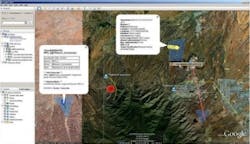UAV sensors being fused by Army engineers
Posted by John McHaleREDSTONE ARSENAL, Ala. 29 March 2011. Army engineers at Redstone Arsenal in Huntsville, Ala., are testing sensor fusion between unmanned aerial vehicle (UAV) platforms. The demonstration uses a synchronization engine prototypes that combine video feeds and sensor data from multiple UAVs operated via an individual ground control station (GCS)."We are opening a gateway to information that we have never done before. Today, you can't switch between one stovepipe intelligence source to another that easily," says Tim Owings, deputy program manager, Army Unmanned Aircraft Systems (UAS). The new system, called the Federated Universal Synchronization Engine, or FUSE, uses software and hardware to fuse different intelligence sources on one viewing screen, including ground moving target indicator (GMTI), electro-optical, infrared, and synthetic aperture radar (SAR) capabilities, Owings says."FUSE is about operator cueing -- to get the operator better intelligence feeds so that he can find targets more rapidly. If you are a Shadow you don't have a moving target indicator. All you have is video. With FUSE -- if you have a Gray Eagle in the same area with an SAR -- you will now be able to see the GMTI on the Shadow GCS," Owings says. FUSE will be particularly helpful when it comes to the "perishability" of certain fast-emerging targets because the fusing of sensor data from multiple sources will allow action to be taken more quickly in response to various combat scenarios, he explains. "If you have information about a guy planting an improvised explosive device (IED) -- if you don't do something now the opportunity to disrupt that event is lost," Owings says. The idea for FUSE emerged out of the findings from Army teams sent to Afghanistan to assess how UAS sensors can be used more effectively, he adds. "What we found was that there was a need to share information better, and we found there was no way for a UAS operator to technically fuse all of the different intelligence sources into an operational picture he could use," Owings says. The Army hopes to have FUSE ready for deployment in about one year, he adds.
